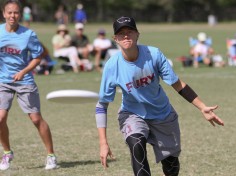As I watched the Club Championships this year, I was disappointed that once again the wind was the biggest story line. As a fan and commentator I think USA Ultimate has a responsibility to get the Championships into a friendly locale. As a coach and player, I don’t really care. The goal is to win regardless of obstacles and conditions. With that in mind, here are some things to consider.
To Punt or Not to Punt
This is a tough question. There have been two recent finals (2011 CUT over Wisco and 2012 Fury over Riot) won by teams that opted not to punt against teams that did punt. That said, the vast majority of high wind games where one team punts and the other team doesn’t are won by the team that punts. In the two finals I mentioned, there were mitigating circumstances. If you are going to punt, you had better be able to stop the other team in the short field. Riot wasn’t really able to stop Fury, in large part because Alex Snyder’s throws were unaffected by the wind. Second, when you punt you are giving the other team a lot of opportunities to score upwind. In 2011, it wasn’t so much that CUT’s upwind offense was awesome, but it was good enough given the number of opportunities that Wisconsin gave them. The best advice I can give you is to punt wisely. It’s not the conditions themselves, but their effect your own team’s offensive and defensive ability.
Disciplined
One common misconception regarding the punt-and-play-d strategy is that it isn’t disciplined. To the contrary, punt-and-d requires incredible discipline. You are committing to a strategy that gives your opponent multiple opportunities to score in the valued upwind endzone. Your commitment to the strategy must be entire. The mental focus required to play that much consistent defense is only possible with discipline. To use this past spring’s Oregon-Michigan semifinal as an example, there were 198 possessions, 180 of which were turnovers. That meant that each team had to stop ~45 upwind attempts. (These are rough calculations.) By my count, Oregon made 3 mistakes in those 45 attempts, two of which led to upwind goals. One of those mistakes was mine in choosing to play zone in the opening possessions. (See below.) The other two were short passes near the upwind endzone when we were going downwind; one was turned and went for a Michigan goal, the other was completed. None of the mistakes were in the transition defense, an often fatal error.
Man or Zone
It is important to move away from the simplistic up-wind = zone, no-wind or down-wind = man strategy. The advantage that a zone has is that it greatly limits the number of options a team has. However, unless you are playing a tight 4-man cup, it actually increases the number of no-pressure options another team has. So while the other team has less to look at, it has much greater control over those choices. They can throw backhands the whole way up the field, while a man-to-man can limit the other team to much more difficult forehands. This was the case in the CUT-Wisco final; Wisconsin’s zone allowed the Carleton handlers to throw little backhands the whole way up the field. It was also the case in the Oregon-Michigan semifinal last spring; giving Callahan-winner Seville her backhand wasn’t the best choice. I really like the zone when the other team is going downwind, particularly if they are punting. If you can get the cup on, you can force them into either a swing pass (yes!) or poor huck. Both have the potential to greatly improve your field position.
Upwind-Downwind Lines
It was interesting to see how the teams at the Club Championships adjusted their lines to deal with the wind. In the women’s division, where O and D-lines are unusual, it wasn’t too big a deal, but in Open where most teams play strict O and D-lines, a lot of the teams faced a tough decision. Sacrifice chemistry? Force your O-line to play downwind defense? Your D-line to play upwind offense? The conditions in Sarasota were a great example of one of the inherent weaknesses of the O-line/D-line system; it’s just not that flexible. In the final, Doublewide was successfully flexible. Revolver mostly stayed with their usual subbing patterns and struggled as some of their offensive players were exposed defensively.
Once you’ve made the strategic decision to adjust your line, here are some tactics to consider. The first technique is to keep lines mostly the same, but adjust one or two players. Maybe you replace your slow-but-saavy O-line cutter with a younger, faster defender when you are receiving going downwind. Or put in a huge hucker to take the upwind shot. If you decide to completely redo your lines, play your best line-up when you are going downwind. Ensure you score those crucial downwinders and prevent your opponent from getting upwinders. Going upwind, take chances. Play your rookies. Put in a big hucker and some big receivers and take a shot. Tied at 7s? Put your best line in and try to steal an upwinder.
Last Thing
If you know it is going to be windy, get out and throw early.
Feature photo of Fury’s Carolyn Finney getting up for the disc in the 2012 final. Photo by Alex Fraser – Ultiphotos.com









Comments Policy: At Skyd, we value all legitimate contributions to the discussion of ultimate. However, please ensure your input is respectful. Hateful, slanderous, or disrespectful comments will be deleted. For grammatical, factual, and typographic errors, instead of leaving a comment, please e-mail our editors directly at editors [at] skydmagazine.com.